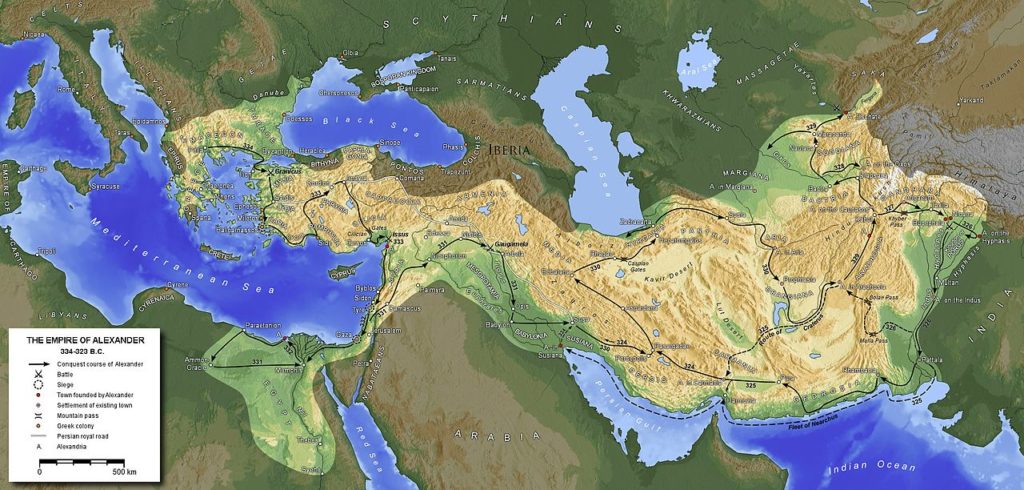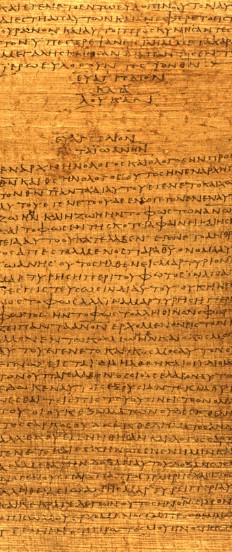New Testament Greek is a dialect of ancient Greek known as Koine. A dialect is a form of a language, distinguished by vocabulary, grammar and pronunciation, which is peculiar to a specific region or social group. In the fourth century BC, several hundred years before the birth of Christ, there was no linguistic unity in Greece. Each city state had its own dialect which was spoken in the region and used for official business. Speakers throughout Greece were able to understand other dialects.
Koine: the Dialect of Alexander the Great
Philip II of Macedon adopted Attic Greek, the Greek spoken in Athens and the surrounding area, as his official language of diplomacy and administration. The spread of Greek to the Middle East and Egypt came with Philip’s son, Alexander. Attic Greek expanded into an international form and became the official and everyday language of Greek cities in the territories conquered by Alexander. A common, simplified form of the Greek language emerged, and Koine became the mother-tongue of these Greek communities and replaced old dialects in Greece.

The Dominance of Attic Greek in Literature
In the first century BC, teachers instructed pupils that language must not develop or change, and that the only correct Greek was that used by classical writers, Attic Greek. It was taught that Koine should be rejected as a product of ignorance and debasement. During the next two centuries, this Atticist movement dominated the Greek taught in schools. Literary prose, on which education was based, increasingly imitated ancient linguistic patterns, and the discrepancy between contemporary speech and the language of literary texts grew.

Language began to be used as a status symbol. The uneducated spoke the living, developing language, which was despised by the wealthy educated class whose use of Attic words and forms was seen as a mark of culture and status. For writing to be acceptable to the educated and cultured, one had to write not as one spoke but in the style in which Athenians spoke in the fourth century BC. Those who wrote the New Testament were more concerned with the nature of their message than with literary pretensions.
Language of the New Testament
At first, Christianity was largely confined to the lower classes, but then began to move among the upper classes of society and the problem of an acceptable linguistic form persisted. Christian writers of the earlierst period wrote as they spoke. But Christian writers whose aim was to convert cultivated pagans had to write and preach in language acceptable to their readers and listeners. Archaic literary language enjoyed great prestige and the New Testament in its lower class language was disagreeable to the upper class Christians. The diglossia was unacceptable and they viewed Koine as an embarrassment, unsuitable for speaking on formal occasions.
In the time of the late Roman Empire, the assertion that the New Testament was written in a language which was neither literary Attic nor a classical style, was construed as an insult of the highest order. Early scholars believed that the Biblical writings, having been inspired by God, must have been written in the highest, most cultured form of Greek. By the early twentieth century, Biblical scholars continued to believe that the New Testament was written in a special variety of Greek which was in use among Jewish communities of the Near East and sought to use this to explain the divergences between its language and the language of literary texts.
Typically, written evidence originates from the upper educated classes while the voice of the lower classes remains silent. But non-literary written texts have been discovered and identified as written by the lower classes. These are inscriptions on stone or potsherd, graffti, and writing on papyrus, and the fragments contain records of the affairs of artisans, peasants, soldiers and slaves. These texts have demonstrated that, rather than being a specialised language all its own, the language of the New Testament is that which was in use by the masses. Of course, one might argue that the ability to keep records or even to write suggests a degree of education and by extension a certain level of wealth which artisans, peasants, soldiers and slaves would not have attained. To counter this argument I would suggest that, for example, slaves might receive an education in order to perform their duties which included providing some education to the children of the household.
It is now accepted that the New Testament was written in the spoken Greek of the time, however, varying degrees of literary pretension exist within it. For example, Luke attempted to write in a more literary style and found it necessary to correct what he found in Mark’s Gospel, while the language of Luke’s contemporary, Josephus, is even more literary in nature. The author of the Letter to the Hebrews wrote in a rhetorical, poetic fashion, in comparison with the Greek of the author of Revelations who made obvious grammatical blunders and Semitic idioms. This author’s first language is likely to have been Hebrew, and is probably not the same John who wrote the Letters of John or the Gospel. It is interesting to note that the Synoptic Gospels (Matthew, Mark and Luke, and so-called because they contain many of the same stories with similar wording, as distinct from John) are the most colloquial in tone, particularly when they report the sayings of Jesus.
Next time, I will discuss some linguistic differences between Koine and the classical Greek in which much of the literature which survives from the fifth century BC is written.

One thought on “What’s the difference between New Testament Greek and Ancient Greek? (Part 1)”